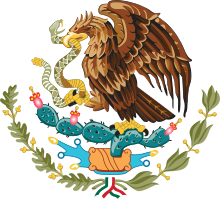Mexico coat of arms
The United Mexican States adopted a coat of arms in 1822 , which to this day is essentially the Mexican state emblem. It shows an eagle on a cactus (an opuntia ) on a rock in a lake, with a snake in its talons.
history

The coat of arms refers to a legend of the Aztecs about the foundation of their city Tenochtitlan (today Mexico City - Ciudad de México). According to legend, their god Huitzilopochtli had prophesied to them that they would see an eagle in such a place, holding a snake between its claws and beak, and that is where they should settle and found their city.
During the first empire of Agustíns de Itúrbide , the eagle wore a crown. The coat of arms was changed in 1823. The prickly pear was now placed on a rock rising out of the water and the whole thing was surrounded by an oak and laurel branch. The second empire of Maximilian of Mexico also had the eagle in its coat of arms, but accessories from the Habsburg and French (Napoleonic appearance of the eagle) monarchies were added. Since then the coat of arms was changed in 1880, 1916, 1934 and for the last time in 1968 at the request of Gustavo Díaz Ordaz . It was designed by Francisco Eppens Helguera . In the same year, when the 1968 Summer Olympics were held in Mexico , a new golden coat of arms was published, which is mainly used by the President, by the "Secretarios" comparable to federal ministers and by the governors. During the tenure of Vicente Fox , the coat of arms of Eppens was not used, only again under Felipe Calderón .
Government coat of arms
Historical coat of arms
State coats of arms
Aguascalientes Coat of Arms
Baja California Coat of Arms
Baja California Sur Coat of Arms
Campeche coat of arms
Chiapas coat of arms
Chihuahua coat of arms
Coahuila Coat of Arms
Colima coat of arms
Durango Coat of Arms
Guanajuato Coat of Arms
Coat of arms of Guerrero
Coat of arms of Hidalgo
Jalisco Coat of Arms
México coat of arms
Mexico City Coat of Arms
Coat of arms of Michoacán
Coat of arms of Morelos
Coat of arms of Nayarit
Coat of arms of Nuevo León
Oaxaca coat of arms
Puebla coat of arms
Querétaro coat of arms
Quintana Roo Coat of Arms
San Luis Potosí Coat of Arms
Sinaloa coat of arms
Sonora's coat of arms
Tabasco coat of arms
Coat of arms of Tamaulipas
Tlaxcala Coat of Arms
Veracruz Coat of Arms
Yucatan Coat of Arms
Coat of arms of Zacatecas






































